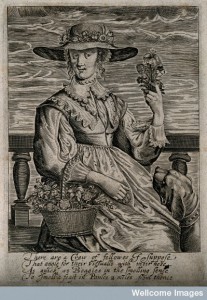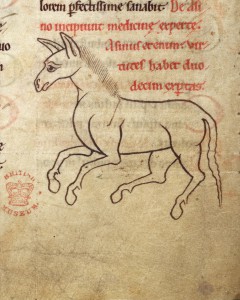Whewell’s Gazette
Your weekly digest of all the best of
Internet history of science, technology and medicine
Editor in Chief: The Ghost of William Whewell
Volume #42
Monday 06 April 2015
EDITORIAL:
Back again after the long Easter weekend, it’s your weekly #histSTM links list Whewell’s Gazette #42, fuller than a basket of Easter eggs with all the best in the histories of science, technology and medicine collected by our busy bunnies from the Internet over the last seven days.
This week saw one of those sensationalist science headlines that journalists love. A medieval recipe for a salve for curing styes appears to be effective against the antibiotic resistant MRSA bacteria. This produced a flurry of activity amongst both medieval and medical historians, as well as those who are both. With Vanessa Heggie from, the by us much loved, H-Word blog leading the pack with a suggestion for “bioprospecting”. Note that word in your computer dictionaries dear readers; it’s a scientific research buzzword of the future. Remember you read it here first.
Taking the lead from Vanessa’s tweet: “Full commentary on the anglosaxon antibiotic coming soon #watchthisspace – @HPS_Vanessa”, we have collected a research lab full of reports on this discovery and its consequences for your delectation to open this weeks edition of Whewell’s Weekly.
The H-Word: Anglo-Saxon antibiotics are just the start – it’s time to start bioprospecting in the past

Leeches were out of favour in Western for about 150 years, before we rediscovered them in the 20th century. Photograph: Reuters
Source: The H-Word
Panacea: What’s Old Is New Again: Medicine’s Blast From the Past
Medievalist.net: Can medieval drugs help modern patients?
New Scientist: Anglo-Saxon remedy kills hospital superbug MRSA
Medievalist.net: Anglo-Saxon medicine is able to kill modern-day superbug, researchers find
Archaeology: 100-Year-Old Salve Recipe Kills MRSA Culture
CNN: Thousand-year-old Angle-Saxon potion kills MRSA superbug
The Guardian: A medieval remedy for MRSA is just the start of it. Powdered poo, anyone?
Youtube: Antibiotics from the medieval medicine cabinet (1)
Quotes of the week:
“I don’t give a damn for a man that can only spell a word one way”. – Mark Twain
“Every man has a property in his own person. This nobody has a right to, but himself”.
John Locke
“If I was independently wealthy I’d be an academic”. – @DublinSoil
“Early in life I had noticed that no event is ever correctly reported in a newspaper.” – George Orwell
“Who does not understand should either learn, or be silent.” ― John Dee
“For I see a man must either resolve to put out nothing new or to become a slave to defend it” – Isaac Newton h/t @KeesJanSchilt
From 1871: ‘Much of history, as usually taught to children, is too much like a bound Police Gazette, a condensed Jack Sheppard.’ h/t @harbottlestores
“Nature makes the organs to suit the work they have to do, not the work to suit the organ.” Aristotle, Parts of Animals.
“The inquisition of Final Causes is barren, and like a virgin consecrated to God, produces nothing.” — Francis Bacon
“A scientific man ought to have no wishes, no affections – a mere heart of stone”. – Charles Darwin (letter to Huxley)
Alchemist insult: “Hollandus had more of the fire-art in his little finger as Helmont in his whole body.” -J. Kunckel h/t Paul Engle @Conciatore_org
“The true alchemists do not change lead into gold; they change the world into words”
W Douglas, 1855.
“Libraries should be open to all – except the censor-“― J,F.K.
“The freedom of putting a book aside is closely allied to that of walking out of performances” – @publichistorian cf.
“I know I generally feel alive and emancipated when I choose to walk out of something” Maggie Nelson h/t @publichistorian
“The multitude of books is making us ignorant.” – Voltaire
“I have a three-day weekend and so many books to read”. – @publichistorian
“The pen is not only mightier than the sword, it is considerably less messy”. – John Laurie
“The pun is mightier than the sword”. – @GustavHolmberg
PHYSICS & ASTRONOMY:
Royal Observatory Greenwich Blog: Women’s History Month – Ruth Belville
Tri-City Herald: Early Hanford worker turns 100
AIP: Historic Sites Initiative
Ptak Science Books: Einstein and Fermi Immigration Papers, National Archive
Dannen.com: Albert Einstein, F.B.I. Interview
Tycho’s Nose: The Nobel Prize winner at the bottom of the garden
Ptak Science Books: Einstein, Frisch, Cockcroft: Atomic Physics Film, 1948
Yovisto: Sin-Itiro Tomonaga and Quantum Electrodynamics
Royal Museums Greenwich: Women’s History Month – 20th Century

Annie
Maunder (centre) preparing to observe the 1900 eclipse in Algiers with the
British Astronomical Association (from E. Walter Maunder (ed.), The Total
Solar Eclipse of May 1900).
AHF: In Memoriam: Evelyne and Larry Litz
academia.edu: “Perhaps irrelevant”: the iconography of Tycho Brahe’s small brass quadrant
Nautilus: The 315-Year-Old Science Experiment
The Renaissance Mathematicus: Emmy the student and Emmy the communist!
Medievalist.net: The Concept of Time in the Medieval World View
Scripta Manent: “Lent approaches with a slow and weary step”
Verso: Einstein and the Astronomers
Classical Astronomy: A Brief History of Lunar Eclipses
Science 2.0: This Year Easter Falls On The Correct Date According To Newton
The Telegraph, Calcutta India: Astronomer without a telescope
Science 2.0: How Is The Date of Easter Calculated? The Science Answer
EXPLORATION and CARTOGRAPHY:
Science Direct: The longitude question
Wonders & Marvels: How I write History…with Chet van Duzer
Slate Vault: A Chart of New Guinea in 1901, When the Island Was Halfway Between Unmapped and Mapped

“New Guinea,” from George Franklin Cram’s 1901 atlas, Cram’s Standard American Railway System Atlas of the World.
David Rumsey Map Collection
Medievalist.net: Sayonara Diorama: Acting Out the World as a Stage in Medieval Cartography and Cyberspace
Longitude Project Blog: Happy Birthday Mr Harrison
MEDICINE & HEALTH:
The Guardian: Australian women in uniform: then and now – in pictures [includes nurses]
Active History.ca: Theme Week: Infectious Disease, Contagion and the History of Vaccines
Active History.ca: “Be Wise – Immunize!” Vaccine Promotion in Canada During the 20th Century
Active History.ca A Brief History of Vaccines in Colonial Africa
MHL: Browse over 3000 digitized volumes of historical medical journals
The Order of the Good Death: Curating a UK Medical Museum: Two Heads Are Better Than One
History of Medicine in Ireland Blog: The historical development of Irish Hospitals and the importance of their records
CHoM News: Staff Finds: L. Vernon Briggs, the Scrapbooker
Contagions: Plasmodium knowesi: A New Ancient Malaria Parasite
Library Queens University: Unrecorded Vesalius first edition discovered at Queen’s University
O Say Can You See?: Midwives on horseback: Saddlebags and science

The nurse-midwife carried two leather saddlebags—one on each side of the horse connected by a strap. She had one pair of saddlebags for general health care, and one for home deliveries. Nearly all babies were delivered at home. These saddlebags are from the 1930s.
History Today: Breastfeeding, corsets and ageing: the mysterious dangers of womanhood
Schuliosh School of Medicine & Dentistry: Top 10 Reasons Why Studying Medical History Will Make you a Better Doctor
The Quack Doctor: Dr Wheeler and the Bacillus of Death
ABC Science: Did arsenic poisoning make gods limp?
History Today: William Harvey and the Circulation of the Blood
Early Modern Medicine: Fumigating for Health
The Conversation: Floating wombs and fumigation – why Gwyneth Paltrow has ‘steam douching’ all wrong
Identities.Mic: What 6 Ridiculous Old-Timey Diseases All Have in Common
Royal College of Physicians: The eyes have it
The Recipes Project: “Look’d Like Milk”: Breastmilk Substitutes in New England’s Borderlands
BuzzFeed: Johns Hopkins Sued For $1 Billion Over Unethical STD Study
Providentia: The Heroin Miracle (Part one of Three)
TECHNOLOGY:
Medievalist.net: A Comprehensive History of Beer Brewing
Yovisto: The Visions of Emanuel Swedenborg
Conciatore: Isaac Hollandus
AEON: Preternatural Machines
City Lab: This 19th Century ‘Stench Map’ Shows How Smells Reshaped New York City
IEEE Spectrum: The Multiple Lives of Moore’s Law
Nemfrog: Telephones for every 100 people on January 1, 1947
PRI: Finding the forgotten women who programmed the world’s first electronic computer
The Belated Nerd: Revell Sells Secrets to the Soviets…For $2.98
Conciatore: Carries the Palm
War Is Boring: The ‘Tsar Bomba’ Was a 50-Megaton Monster Nuke: But it was far too big to ever be a practical weapon
How We Get To Next: Happy 150th Birthday Crossness Pumping Station!
Bard Graduate Center: The Interface Experience: Forty Years of Personal Computing
EARTH & LIFE SCIENCES:
History of Geology: The Four Layers of the Earth
TrowelBlazers: Bertha “Birdie” Parker

Bertha c. 1930 at Gypsum Cave, Nevada, with throwing sticks. Source: Acc. 90-105 Science Service Records, Smithsonian Institution Archives via Flickr.
Embryo Project: Telomerase in Human Development
Wonders & Marvels: The Secret History of Cheese
Smithsonian: Department of Invertebrate Zoology News –No Bones: The Inspiring Mary Jane Rathbun – Women’s History Month Highlight

Mary Jane Rathbun, 1927, by John Howard Pearce (Acc. 90-105 – Science Service, Records, 1920s-1970s, Smithsonian Institution Archives)
TrowelBlazers: Gudrun Corvinus
Embryo Project: James William Kitching (1922-2003)
Fossil History: A BIG Month for Paleoanthropology: March Roundup
sealevelrise: The Seal Rock
Notches: Franca Viola says ‘No’: Gender violence, consent, and the law in 1960s Italy
Letters from Gondwana: The Megafauna Extinction in South America
Science News: Ancient hominids moved into Greece about 206, 000 years ago
Open Spaces: Recognizing Women’s Vital Contribution to Wildlife Conservation
The Public Domain Review: Tractatus de Herbis (ca. 1440)
Science News: Bright bird plumage resulted from natural, sexual selection
This View of Life: The Spandrels Of San Marco Revisited: An Interview with Richard C. Lewontin
The Return of Native Nordic Fauna: Beaver for Lent
Embryo Project: St. George Jackson Mivart (1827–900)
Embryo Project: Elizabeth Blackburn, Carol Greider and Jack Szostak’s Telomere and Telomerase Experiments (1982-1989)
Science 2.0: Darwin’s ‘*Strangest Animals Ever Discovered’ Solved
Palaeoblog: Born This Day: Ralph A. Bagnold
Vox CEPR’s Policy Portal: The myth of Europe’s Little Ice Age
CHEMISTRY:
The Guardian: Robert Bunsen did a whole lot more than invent the Bunsen burner
META – HISTORIOGRAPHY, THEORY, RESOURCES and OTHER:
Dr Jennifer Evans: RSA15 Berlin
Literacy of the Present: The Ignorant Library
OUP Blog: Cinderella Science

Charles Henry Bennett, ‘Wonderful Plants’, from John Cargill Brough, The Fairy-Tales of Science (1859). Public Domain via Wikimedia Commons. – See more at: http://blog.oup.com/2015/03/cinderella-science/?utm_source=twitter&utm_medium=oupacademic&utm_campaign=oupblog#sthash.7b01S79M.dpuf
Jack Hoy.com: Summary of ‘Computing Machinery and Intelligence’ (1950) by Alan Turing
The many-headed monster: Food for thought: An Introduction to Theory via the History of Food and Drink
Situating Science: Letter from the Director: Situating Science and Beyond
University of Leicester: Former history student awarded scientific instrument prize posthumously
PLOS Blogs: How Articles Get Noticed and Advance the Scientific Conversation
University of Toronto Press: Canadian Journal of History 49.3 – History of Medicine
Wellcome Trust: New Capital Award for the Museum of Science & Industry
Wired: We Need To Stop Ignoring Women Scientists
UCL Department of Economics: The First 100 Years
American Science: Celebrating 50 Years of JAS-BIO
The H-Word: Destroyed Snowden laptop: the curatorial view

The remains of the PC desktop and the Mac laptop that GCHQ came to the Guardian’s offices in King’s Place and destroyed. Only the laptop is displayed in the exhibition. Photograph: Sarah Lee
Homunculus: Who are you calling a journalist?
Conciatore: Don Antonio de’ Medici
Advances in the History of Psychology: Call for Participation: Interviews with Archival Researchers
AIP: Telling the Stories of Women and African Americans in the Physical Sciences
Wo’s Weblog: Please, don’t put your papers on academia.edu
The Guardian: Why scientific truth may hurt
bonæ litteræ: What’s the purpose of a conference? Reflections on RSA 2015 Part I & Part II
ESOTERIC:
Inside MHS Oxford: Alchemy and the Laboratory
The Recipes Project: Animal Charms in the Later Middle Ages
BOOK REVIEWS:
From the Hands of Quacks: Sounds of Modern History: Auditory Culture in 19th and 20th Century Europe
Popular Science: A Scientist in Wonderland
Science Book a Day: Interviews David Wright author of Downs: The history of a disability
academia.edu: The Newton Papers: The Strange and True Odyssey of Isaac Newton’s Manuscripts
Ashgate Publishing Blog: The history of intelligence and ‘intellectual disability’
Forbes: ‘sapiens’: An All Too Brief History of Humanity
Science Book a Day: What is Life? How Chemistry Became Biology
Popular Science: Einstein Relatively Simple
New Scientist: Eye of the Beholder: Life through a camera obscura
Literary Review: Three of a Kind: Naturalists in Paradise: Wallace, Bates and Spruce in the Amazon
The Steven Weinberg Controversy:
Physicist Steven Weinberg has written a book about the history of science that is not only very strongly Whiggish in its historical approach but also castigates historians of science for not being Whiggish. He repeated this point of view in an article this week for the Guardian in which he also recommends thirteen best science books for the general reader. We have collected together some relevant blog posts on the resulting controversy provoked by Weinberg’s attitude.
The Guardian: To Explain the World: The Discovery of Modern Science by Steven Weinberg
The Guardian: Science and nature: Point of view: Steven Weinberg: the 13 best science books for the general reader
The Wall Street Journal: Why Scientists Shouldn’t Write History
(If you run into a pay wall google the title, Why Scientists Shouldn’t Write History, and click on the first link!)
Double Refraction: Why historians shouldn’t write off scientists: On Steven Shapin’s review of Steven Weinberg’s Explain the World
Galileo’s Pendulum: Science by authority is a poor model for communication
Homunculus: This explains everything
The H-Word: An alternative 13 best books about science?
Forbes: Recommended science books for non-scientists
NEW BOOKS:
Historiens de la santé: Beastly encounters of the Raj: Livelihoods, livestock and veterinary health in India, 1790-1920
University of Chicago Press: Wicked Intelligence: Visual Art and the Science of Experiment in Restoration London
Wiley: The Clever Object
Historiens de la santé: The Fate of Anatomical Collections
Historiens de la santé: The Development of Brain Banks in the UK c.1970–c.2010
Ashgate: Geography, Technology and Instruments of Exploration
Historiens de la santé: Anatomy and Anatomist in Early Modern Spain
Wellcome Trust: Bookshelf: Latest Releases
THEATRE:
FILM:
TELEVISION:
SLIDE SHARE:
Scientific American: Saturn: A History [Slide Show]
VIDEOS:
iai tv: This is Our Church: Science as religion
Ri Channel: The Nature of Things – Crystals and Gems
Youtube: Scientists of the National Trust: Isaac Newton
CSH: Oral History: Ernst Mayr on Historian Michael Ruse
Vimeo: Laura J. Snyder Eye of the Beholder Reviewed by John w. Wilbanks
It’s OK to be Smart: Richard Feynman The Experimenters
Youtube: Revelations: Experiments in Photography trailer
RADIO:
BBC Radio 4: Far Side of the Moore
PODCASTS:
The Take Away: State Secretes Revealed? Hydrogen Bomb Architect Moves Forward with Memoir
CHF: Fads and Faith: Belief vs. Fact in the Struggle for Health
Here & Now: ‘Becoming Steve Jobs’ Attempts to Dispel Myths Chart an Evolution
ANNOUNCEMENTS:
Wikimedia UK: Wikipedia Science Conference, Wellcome Collection Conference Centre, London, 2-3 September 2015
CHF: The Museum at CHF – Starting 4 April extended weekend hours
University of Chicago: CHSS: Lecture: “The Unfit Darwinist: Disability, Slander and the Evolution Trial Before Scopes.” Adam Shapiro, 10 April 2015
University of Chicago: CIS: Colloquium: Repurposing Magic 10 April 2015
The Philosophy of Science Association: Announcements
Folger Shakespeare Library: Exhibition: Ships, Clocks & Stars: The Quest for Longitude 19 March–23 August 2015
Sussex Humanities Lab: Showcasing the Digital 8 April 2015
Royal College of Physicians: Exhibition: Scholar, courtier, magician: the lost library of John Dee January–July 2016
Pembokeshire Coast National Park: Exhibition: Wallace: The Forgotten Evolutionist? will be on display at Oriel y Parc until 25 November 2015.
NIH: U.S. National Library of Medicine: History of Medicine Lectures for 2015
University of Oxford: Lecture: Naturalists in paradise 24 April 2015
National Maritime Museum: Harrison Decoded: Towards a perfect pendulum clock 18 April 2015
The Royal Society: Archival afterlives 2 June 2015
NYAM: Presentations for History of Medicine Night: 19th and 20th Century Stories 6 May 2015
NIH: U.S. National Library of Medicine: NLM to Host “Images and Texts in Medical History: An Introduction to Methods, Tools, and Data from the Digital Humanities” 11-13 April 2015
University of Reading: The Ure Museum of Greek Archaeology: Exhibition: The Antikythera Mechanism February–April 2015
HWO: History Workshop Online: Call for Contributor
Institute of English Studies: School of Advanced Studies London: Biennial London Chaucer Conference: Science, Magic and Technology 10-11 July 2015: Registration & Programme
LOOKING FOR WORK:
Royal Astronomical Society: Library Assistant (part time)
University of Exeter: Exeter REACT Collaborative Studentship: Playing with heritage: a historical and practical investigation of gamification in the heritage museum














Pingback: To Explain the Weinberg: The discovery of a Nobel Laureate’s view of the history of science | The Renaissance Mathematicus